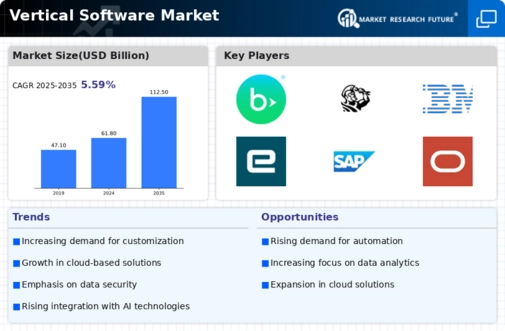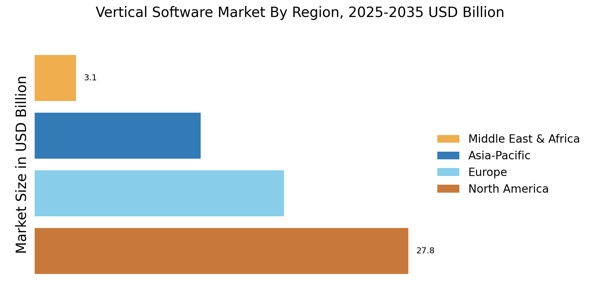Rising Adoption of Cloud Solutions
The Vertical Software Market is experiencing a notable shift towards cloud-based solutions. Organizations are increasingly adopting Software as a Service (SaaS) models, which offer flexibility, scalability, and cost-effectiveness. According to recent data, the cloud segment is projected to grow at a compound annual growth rate (CAGR) of approximately 20% over the next five years. This trend is driven by the need for remote accessibility and collaboration, allowing businesses to operate efficiently regardless of location. As more companies migrate to the cloud, the demand for vertical-specific software solutions that cater to unique industry needs is likely to rise, further propelling the Vertical Software Market forward.
Emergence of Industry-Specific Solutions
The Vertical Software Market is witnessing a trend towards the development of industry-specific solutions tailored to meet the unique needs of various sectors. This specialization allows software providers to offer more relevant features and functionalities, enhancing user satisfaction and operational efficiency. For example, software designed for the manufacturing sector may include features for supply chain management and production scheduling, while solutions for the healthcare industry may focus on patient management and electronic health records. This trend is expected to contribute to a market growth rate of approximately 18% over the next few years, as businesses increasingly seek software that aligns closely with their operational requirements.
Regulatory Compliance and Industry Standards
In various sectors, adherence to regulatory compliance and industry standards is becoming increasingly critical. The Vertical Software Market is responding to this need by developing specialized software solutions that help organizations meet legal and regulatory requirements. For instance, industries such as healthcare and finance are subject to stringent regulations, necessitating software that ensures compliance. The market for compliance-related software is expected to expand significantly, with estimates suggesting a growth rate of around 15% annually. This driver indicates a strong demand for vertical software that not only streamlines operations but also mitigates risks associated with non-compliance.
Increased Investment in Digital Transformation
Organizations across various sectors are prioritizing digital transformation initiatives, which is significantly impacting the Vertical Software Market. Companies are investing in technology to enhance their operational capabilities, improve customer engagement, and streamline processes. This shift is reflected in the projected increase in IT spending, with estimates indicating a growth of around 10% annually in software investments. As businesses embark on their digital transformation journeys, the demand for vertical software solutions that facilitate these changes is likely to rise, driving innovation and growth within the Vertical Software Market.
Growing Focus on Data Analytics and Business Intelligence
The integration of data analytics and business intelligence tools within the Vertical Software Market is becoming increasingly prevalent. Organizations are recognizing the value of data-driven decision-making, leading to a surge in demand for software that provides actionable insights. The market for analytics software is projected to grow at a CAGR of 25% over the next few years, reflecting the increasing reliance on data to enhance operational efficiency and customer satisfaction. As businesses seek to leverage their data assets, vertical software solutions that incorporate advanced analytics capabilities are likely to gain traction, thereby driving growth in the Vertical Software Market.


















Leave a Comment